 Western
Toad (Bufo boreas) Western
Toad (Bufo boreas)Body, 2 2/5 to 4 5/8 inches; covered with
rounded warts. Found in open valleys, high mountains, wet
meadows, and lake areas. Inhabits the San Francisco Bay
region. Active at night. Seeks shelter beneath logs,
rocks, and boards and in burrows. Breeds from January to July.
Spawns in water; eggs in long strings. |
 Pacific
Pond Turtle (Clemmy marmorata) Pacific
Pond Turtle (Clemmy marmorata)Shell, broad and short, average
length, about 6 inches, maximum length, about 7 inches. Found
in the San Francisco Bay region. Inhabits quiet ponds and
streams; sometimes enters the sea. Aquatic but basks on land;
often seen on logs or rocks in or close to water. Can be
trapped, easily caught with hooks carrying minnows, earthworms or
lumps of liver. Diets chiefly on small animals. Female
lays eggs from about June to August (mostly mid-June to mid-July) in
holes dug on shore; 5 to 11 eggs deposited at one time.
Hibernates in mud at the bottom of water during the winter months.
|
 Harbor
Seal (Phoca vitulina) Harbor
Seal (Phoca vitulina)About 5 feet. No external ears; no
underfur. Hind limbs (flippers) can not be brought forward,
making it difficult to move on land. Gets about by wriggling
when not in the water. Inhabits harbors and bays (San
Francisco Bay). Feeds on mollusks, crustaceans, and fish.
young seals (1 or 2 per litter) born in early spring. |
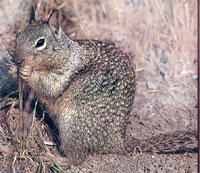 California Ground
Squirrel (Citellus beecheyi) California Ground
Squirrel (Citellus beecheyi)Body, 9 to 11 inches; tail, 5 to 9
inches. Prefers open country and grasslands. Found
throughout the Bay area. One litter (4 to 10 individuals) a
year. Young born in spring. Food consists of seeds, fruits,
acorns, roots, bulbs, and meat. Carries fleas which may
transmit bubonic plague.
|
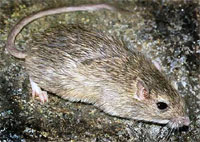 California
Pocket Mouse (Perognathus californicus) California
Pocket Mouse (Perognathus californicus)Only pocket mouse common
in Bay area today. Body, 3 1/5 to 3 1/2 inches; tail, 4
to 5 4/5 inches. Forages at night for seeds and grain.
Carries food in fur-lined "pockets" (pouches), one on each side of
its mouth; sotres food in small pits along passageways in burrow
system. Likes open and semiopen country and slopes covered
with chaparral. Produces 4 to 7 young in each litter; more
than one litter a year. |
|
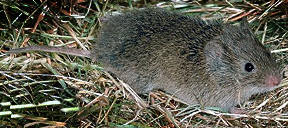 California
Vole (Microtus californicus) California
Vole (Microtus californicus)
Tunnel digger; needs an unobstructed entrance when
scampering from its enemies (snake, hawk, owl, fox, coyote, bobcat,
weasel, badger, and skunk). Body, 4 3/4 to 5 2/3 inches; tail,
1 3/4 to 2 4/5 inches. Ears nearly hidden by fur.
Prefers stream banks, grassy meadows, and salt marshes. Ranges
throughout the Bay area. Produces 2 to 9 young in a litter;
several litters a year. Independent at the age of two weeks.
|
|
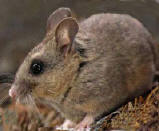 California
Mouse (Peromyscus californicus) California
Mouse (Peromyscus californicus)
Body, 3 4/5 to 4 3/5 inches; tail 5 to 5 4/5 inches. Large
ears. Prefers to live in chaparral-oak areas. Common Bay
region mammal. Frequently found in the nests of wood rat.
|
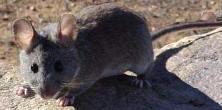 Dusky-footed
Wood Rat (Neotoma fuscipes) Dusky-footed
Wood Rat (Neotoma fuscipes)Body, 7 3/5 to 9 inches; tail, 6 4/5
to 8 2/3 inches. Large ears. Common in Bay region.
Active at night. Prefers dense chaparral or woods.
Builds stick-pile lodge on the ground or in tree. Makes its
nest of shredded bard and dry grass inside the lodge. Nest may
hold mice, lizards, salamanders, snails, and beetles. Produces
3 to 4 young in each litter; more than one litter a year. Food
consists of acorns, seeds, leaves, grains, roots, and fruits. |
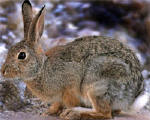 Desert Cottontail (Sylvilagus auduboni) Desert Cottontail (Sylvilagus auduboni)
Body, 12
to 15 inches; ear, 3 to 4 inches. Inhabits burrows or shallow
depressions; also hides in berry patches. Ranges throughout
the Bay area. Produces 2 to 6 young in each litter; two or
more litters a year. Eats grasses, leaves, and fruits.
|
 Botta Pocket Gopher (Thomomys bottae) Botta Pocket Gopher (Thomomys bottae)
Body 4 4/5
to 7 inches; tail, 2 to 3 3/4 inches. Strong claws.
Powerful incisors penetrate hard soil, often hard-packet road beds.
Called the "little bulldozer' because chin and chest are used to
push dirt along tunnel. Carries food and nest material in
fur-lined cheek pouches, one on each side of its mouth. Nests
in deep burrows. Ranges throughout the Bay area. Usually
one litter (1 to 13 individuals) a year. Eats green stalks,
grains, roots, bulbs, and tubers. |
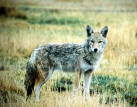 Coyote
(Canis latrans) Coyote
(Canis latrans)Swift runner; often hunts in teams. Body, 32
to 37 inches; tail, 11 to 16 inches; height at shoulder, 23 to 26
inches. Common in Bay region. Likes open country.
One litter (3 to 9 individuals) a year. Eats rodents, rabbits,
and carrion. |
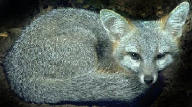 Gray Fox (Urocyon cinereoargenteus) Gray Fox (Urocyon cinereoargenteus)
Keen sense of
smell and hearing. Body, 21 to 29 inches; tall, 11 to 16
inches; height at shoulder, 14 to 15 inches. Lives primarily
in chaparral or chaparral-oak regions. Ranges throughout the
Bay area. Dens in crevices or under large rocks. One
litter (2 to 5 individuals) a year. Eats fruits, insects,
rodents, and rabbits. |
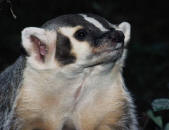 Badger (Taxidea taxus) Badger (Taxidea taxus)
Body 18 to 22 inches;
tail, 4 to 6 inches. Likes open country. Digs easily in
hard soil. Makes burrows or dens deep underground.
Ranges throughout the Bay area. One litter (1 to 4
individuals) a year. Eats reptiles, rabbits, and rodents.
Leaves trail of potholes and piled earth when digging for food.
|
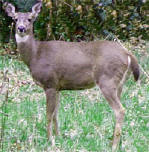 Black-tailed Deer (Odocoileus hemionus columbianus) Black-tailed Deer (Odocoileus hemionus columbianus)
Body, 58 inches; tail 5 1/2 inches, all black on upper surface;
height at shoulder, 3 feet. Prefers forests, woodland, and
chaparral. Ranges throughout the Bay area. Young (1 to 3
individuals) born in spring or early summer. Eats plants.
|
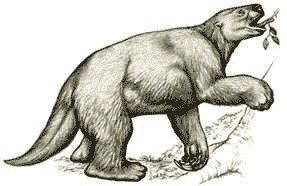 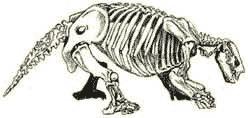 Ground
Sloth (Paramylondon harlani) Ground
Sloth (Paramylondon harlani)Common throughout North America
during the Pleistocene. Height at shoulder, about 4 feet;
massive and powerful claws. Moved slowly and with great
difficulty. Sabercat, dire wolf, and probably bear were its
enimies. |
 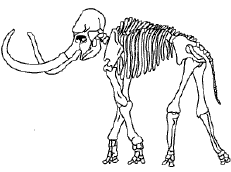 Irvington Mammoth (Mammuthus columbi) Irvington Mammoth (Mammuthus columbi)
Large and
heavy; height at shoulder, about 10 1/2 feet; molars, high-crowned
with many ridges. Abundant during the Pleistocene.
Related to mastodon. "Mammoth" is a term general applied to
extinct elephants. |
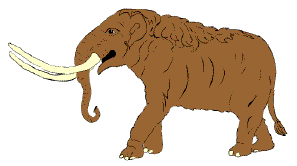 Irvington Mastodon (Mammut americanus) Irvington Mastodon (Mammut americanus)
Smaller
than the mammoth. Height at shoulder, from 6 to 9 feet; teeth,
low-crowned with few ridges; tucks and lower jaw, whort-as in modern
elephant. |
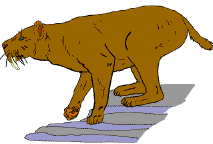 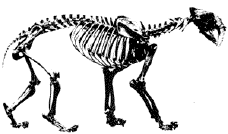 Irvington Sabercat (Smilodon californicus) Irvington Sabercat (Smilodon californicus)
Larger
than the modern tiger; short tail; strong forelegs with powerful
claws. Lower canines, small; upper canines-long, curved
sabers-used for stabbing thick-skinned prey (probably mammoths,
mastodons, and ground sloths). Lower jaw opened to form a
right angle-90 degrees. |
|
|